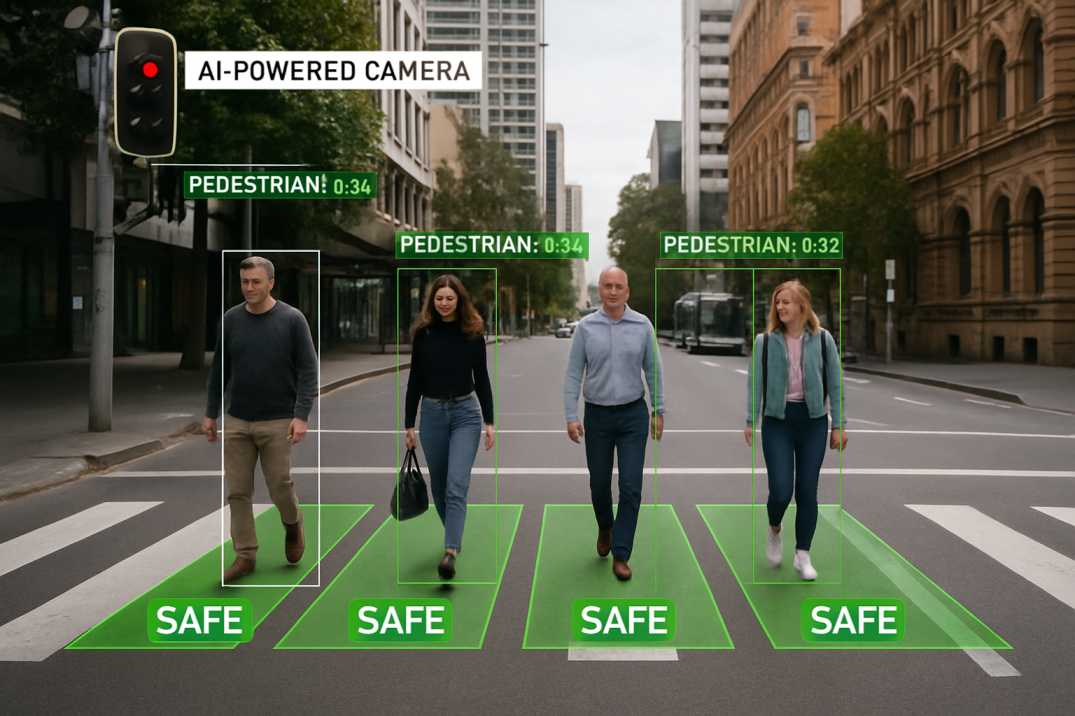Contact Us
RoadVision AI
Private Limited
Office No. 308 & 310, B Block
Ansal Chamber - 1, Bhikaji Cama Place,
Near Engineers India Limited (EIL) Bhawan, New Delhi - 110066
© 2024 | RoadVision AI | All rights reserved
Australia's rapidly urbanizing cities face increasing challenges in ensuring pedestrian safety and cyclist protection. With rising traffic congestion, growing populations, and sustainability goals, governments and urban planners are prioritizing AI road safety audit technologies to modernize traditional safety assessments. These solutions enable digital road safety systems that support real-time monitoring, risk detection, and informed decision-making.
Leveraging AI-based pedestrian and cyclist monitoring technologies is becoming essential for enhancing road asset management in Australia. Through advanced AI road safety surveys, local councils and transportation authorities can reduce fatalities, enhance urban mobility, and align with the National Road Safety Strategy.

Australia’s road safety performance is governed by the National Road Safety Strategy 2021–30, which aims to reduce road trauma by 50% and deaths by 30% by 2030. However, vulnerable road users—particularly pedestrians and cyclists—remain at high risk in densely populated urban environments like Sydney, Melbourne, and Brisbane.
Traditional manual inspections are limited in frequency, objectivity, and responsiveness. AI road safety inspection platforms offer continuous, scalable, and automated data capture and analysis. This is where digital road safety systems come into play—by enabling proactive interventions rather than reactive responses.
Modern AI pedestrian safety systems deploy camera-based sensors and computer vision algorithms to:
These systems also integrate with traffic survey tools like RoadVision AI Traffic Survey, which analyze vehicle-pedestrian interactions for smarter urban design.
Implementing AI in road asset management in Australia offers long-term infrastructure, safety, and financial benefits:
By integrating AI road safety survey data with road inventory inspection tools like RoadVision AI, municipalities can prioritize investment in high-risk areas.
The Austroads Guide to Road Safety and Australian Road Rules emphasize safe infrastructure planning, visibility, lighting, and crossing aids. AI-based systems complement these rules by:
Compliance with national regulations is critical not only for safety but also for funding and insurance.
As cities evolve, digital road safety systems enable planners to:
The shift toward AI road safety inspection ensures continuous monitoring, enabling cities to adapt in real-time.
Explore more in RoadVision AI Case Studies.
With the ongoing development of smart cities, AI-based pedestrian and cyclist monitoring will be at the core of safe, sustainable mobility in Australia. Integrating AI road safety survey tools into city infrastructure will not only reduce accidents but also support broader climate, health, and accessibility goals.
The transformation of road asset management in Australia is underway, and AI road safety audit technologies are proving indispensable. By deploying AI pedestrian safety systems, urban planners can ensure safer roads, enhance data-driven decision-making, and meet national safety targets.
RoadVision AI is revolutionizing roads AI and transforming infrastructure development and maintenance with its cutting-edge innovations in AI in roads. By leveraging Artificial Intelligence, digital twin technology, and advanced computer vision, the platform performs comprehensive road safety audits, enabling early detection of potholes and other surface issues for timely repairs and improved road conditions. The integration of pothole detection and data-driven insights through AI also enhances the accuracy of traffic surveys, helping address traffic congestion and optimize road usage. Focused on building smarter roads, RoadVision AI ensures full compliance with Austroads geometric design guidelines and IRC Codes, empowering engineers and stakeholders to reduce infrastructure costs, minimize risks, and improve road safety and transportation efficiency.
For cities and transportation bodies looking to elevate their safety infrastructure, AI-based digital road safety systems are the future.
Book a demo with us today to explore how RoadVision AI can help you improve pedestrian safety, optimize infrastructure investments, and lead the way in smart mobility.
Q1. How does AI improve pedestrian safety?
AI systems detect pedestrian movements, analyze traffic interactions, and flag hazardous zones in real time, enabling preventive safety measures.
Q2. Are AI road safety systems compliant with Australian regulations?
Yes, systems like RoadVision AI align with Austroads guidelines and national safety strategies.
Q3. What is the role of AI in road asset management in Australia?
AI helps cities track road and footpath conditions, optimize maintenance schedules, and improve overall road safety through smart data.